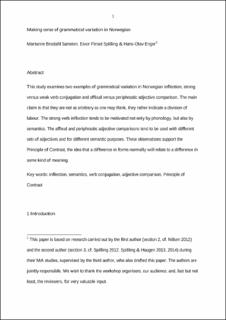| dc.contributor.author | Enger, Hans-Olav | |
| dc.contributor.author | Spilling, Eivor Finset | |
| dc.contributor.author | Sameien, Marianne Brodahl | |
| dc.date.accessioned | 2023-06-22T11:09:15Z | |
| dc.date.available | 2023-06-22T11:09:15Z | |
| dc.date.created | 2018-10-19T14:41:19Z | |
| dc.date.issued | 2018 | |
| dc.identifier.citation | Reorganising Grammatical Variation: Diachronic studies in the retention, redistribution and refunctionalisation of linguistic variants. 2018, 209-230 | en_US |
| dc.identifier.isbn | 9789027201645 | |
| dc.identifier.uri | https://hdl.handle.net/11250/3072662 | |
| dc.description.abstract | This study examines two examples of grammatical variation in Norwegian inflection, strong versus weak verb conjugation and affixal versus periphrastic adjective comparison. The main claim is that the choice of variants is not as arbitrary as one may think, which rather indicates a division of labour. The strong verb inflection tends to be motivated not only by phonology, but also by semantics. The affixal and periphrastic adjective comparisons tend to be used with different sets of adjectives and for different semantic purposes. These observations support the Principle of Contrast, the idea that a difference in form normally relates to a difference in meaning. | en_US |
| dc.language.iso | eng | en_US |
| dc.relation.ispartof | Reorganising Grammatical Variation: Diachronic studies in the retention, redistribution and refunctionalisation of linguistic variants | |
| dc.title | Making sense of grammatical variation in Norwegian | en_US |
| dc.title.alternative | Making sense of grammatical variation in Norwegian | en_US |
| dc.type | Chapter | en_US |
| dc.type | Peer reviewed | en_US |
| dc.description.version | acceptedVersion | en_US |
| dc.description.version | | |
| dc.source.pagenumber | 209-230 | en_US |
| dc.identifier.doi | https://doi.org/10.1075/slcs.203.08sam | |
| dc.identifier.cristin | 1621771 | |
| cristin.unitcode | 223,18,20,0 | |
| cristin.unitname | Institutt for språk og litteratur | |
| cristin.ispublished | true | |
| cristin.fulltext | postprint | |
| cristin.qualitycode | 2 | |
